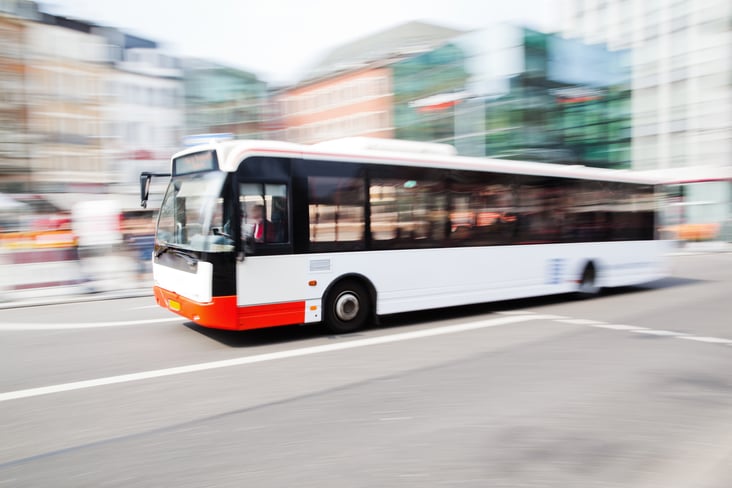
The “Dwell Time” is the time that a vehicle is stationary at a bus stop and is highly dependent on the time it takes passengers to board and alight the vehicle. A long dwell time not only lengthens the journey, but also affects the reliability of the service.
In a recent example in the UK it took 15 minutes for a bus to be loaded on a service that should have a 10 minute frequency.
The current system
As passengers board the bus, many don’t know what ticket they want, while some buy tickets with cash and often they don’t have the right change. Loading time would inevitably be improved with a contactless ticketing system (cEMV). Passengers can use a simple “tap-on” with a bank or credit card to pay the fare. But how does this approach impact dwell times?
A new challenge
With “tap-on” comes a new challenge for transport systems that charge by zone or distance: A queue to “tap-off” before leaving the bus.
After people have identified their stop, gathered their belongings and made their way to the “tap-off” reader, which is typically the same device used for “tap-on”, they now need to find the same card and “tap-off”.
The “tapping-off” process doesn’t usually start until the bus is stationary at the bus stop and “tapping-on” can’t start until all the passengers have “tapped-off” and left the bus. This is further impacting dwell times.
The Manchester Evening News reported that if you don't “tap-out” of Metrolink then your account is charged an incomplete journey fare. Charges for incomplete journeys do not count towards the daily or weekly caps, further penalising a passenger who simply forgets to do so. In other systems, the highest fare in the network is charged by default to passengers who don’t tap out. This puts further pressure on customer care channels to reverse transactions and impacts satisfaction ratings.
Upgrade the contactless experience with FAIRTIQ
With FAIRTIQ, people check in with their smartphones before boarding, confident that they will be charged the best and correct fare. At their destination they can check out after leaving the bus, even several minutes later. The app is designed to recognise which stop the passenger got off at, without fear of overcharging.
FAIRTIQ’s Smart Stop feature, reminds passengers if they forget to check-out. The FAIRTIQ transport mode detection will also detect that they are no longer on public transport and ask them if they want to check-out. It will automatically check them out after the last public transport stop and they will not be subject to excess fares, incomplete journeys or fines.
The FAIRTIQ approach improves dwell time as both check-in and check-out take place outside of the vehicle.
Actively encouraging all-door boarding
Checking-in and checking-out before entering the vehicle with FAIRTIQ, means that all the doors can be used for boarding and alighting. This significantly improves the passenger experience, reduces dwell time and helps bus services to run on time. Reducing dwell time also reduces traffic congestion as whilst the bus is stopped, it is typically creating an obstacle for other road users.
This video shows a comparison between all-door boarding and front door only boarding.

It shows:
| All-door boarding | 37 Passengers | 26 Seconds |
|---|---|---|
| One door boarding | 35 Passengers | 1 Minute, 19 Seconds |
Several studies have already been conducted in North America on all-door boarding with key findings:
- NACTO - Better Boarding, Better Buses: Streamlining Boarding & Fares found that off-board fare collection can cut per-passenger dwell time by half or more.
- Muni, San Francisco - SFMTA’s Muni system implemented all-door boarding systemwide in 2012 and found that dwell times fell by 37% and the service is 42% more consistent.
Additional reliable hardware needed
All-door boarding can be implemented with cEMV, however reliable validators at each door are needed to process tap-ons and tap-offs. This is a major investment for operators, and requires ongoing maintenance. The FAIRTIQ approach enables all door boarding without any hardware.
What about the driver?
With modern buses and congested roads, the driver has enough to do concentrating on driving, keeping to time and helping the passengers that really need it. With conflicts related to fares increasing, the risk for drivers is also increasing and all-door boarding reduces the potential for flashpoints. This can help attract and retain drivers and prevent unnecessary delays. Fraud detection can be done safely in the back-office.
The bottom line
FAIRTIQ Smart Ticketing is a valuable companion to improve dwell times and implement all-door boarding without the expense of validators at all the doors.
More reliable and faster services help reduce cost, greatly increase passenger satisfaction and encourage more travellers to switch to public transport.







Share